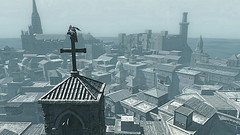 Gamers now are accustomed to linear narratives, playing through a sequence of events with no choice or impact on the direction the story takes.
Gamers now are accustomed to linear narratives, playing through a sequence of events with no choice or impact on the direction the story takes.
Most of us are getting used to branching narratives, simple option systems that open up differing dialogues, games areas and endings.
But Assassin’s Creed 2 is the first mainstream game I’ve played to make parts of the plot entirely optional and intentionally obscure.
First things first: I’m going to focus on Assassin’s Creed 2 in this post. There’s a lot to be said about narrative in the first game, but I’m the wrong person to write it because I found the cut scenes impossibly dull. So dull, in fact, that I generally went to put the kettle on while they happened. There are still plot points I’m unsure of as a result.
On the other hand, the second game cut scenes are slick, interesting and – crucially – well-voiced. Assassination scenes are limited to two or three sentences at most – sometimes still very incongruous, but much less flow-breaking and tea-inducing.
There are two congruent narratives running through the game – the story of Desmond, living in the present day, who has just escaped from the evil Templars who were forcing him to relive his ancestral memories, and is now working with the good Assassins, who are, um, asking him very nicely to relive his ancestral memories.
The second narrative is that of Ezio di Auditorre, the subject of Desmond’s memories and the main focus of the game. Desmond learns the Assassin skills he needs through living Ezio’s life, learning how to use a hidden blade and fall off incredibly tall buildings while suffering absolutely no ill effects. Oh, and some stuff about 15th-century Florentine intrigue and conspiracy.
Where things get interesting is the third narrative. The game doesn’t force you to get involved in what it neatly describes as “The Truth”. At no point does it force it on you. There are signposts but no map markers, hints but no spoilers, and not once are you hindered by choosing not to explore the hidden story.
At a fairly early point, Desmond is asked to find a weird glowing glyph on a building. If you do, you discover a password-protected encrypted file, and must solve a simple puzzle to reveal a snippet of narration and a video file.
There are 20 of these, each puzzle more difficult than the last. The videos and narration add up to reveal a vital and tantalising slice of the Assassin’s Creed backstory that provides clues to the next game and rounds out the game’s cliff-hanger ending in a very satisfying way. It leaves you with answers that lead to more questions.
But even within the puzzles there are more stories. Each puzzle takes real-world historical events, or great works of art, or scientific breakthroughs, and links them intricately to a massive web of conspiracy. Combined with Ezio’s narrative – which tallies closely with real-world events throughout – the game edges closer and closer to alternate reality territory.
And then you find the puzzles within the puzzles. Messages encrypted in Morse code within paintings within the glyphs, never acknowledged or explained. There are dozens of these, easy to miss, even easier to ignore, but each one is decipherable.
The impact of these little asides is not merely to problematise the existing story – adding vignettes and asides that most players simply are unaware of – but also to trouble the relationship between the game and the real historical events it links to. Forcing players to go beyond the fourth wall to decipher puzzles opens up the structure of the story to deeper interpretations than are possible in most games. Assassin’s Creed 2 positions itself, like Dan Brown’s Da Vinci Code, as part fiction, part fact, and hence blurs the lines between the two. Complex analyses are springing up, not only solving the obvious puzzles but the hidden ones too, and players are using those analyses to attempt to uncover the “true” story of the game – the history of the Assassins and Templars. In effect, gamers are creating a fictional backstory using factual history and pointers from within the game. It’s a collaboration and a fascinating puzzle – and entirely optional.
Also it’s a lot of fun to throw yourself off tall buildings.